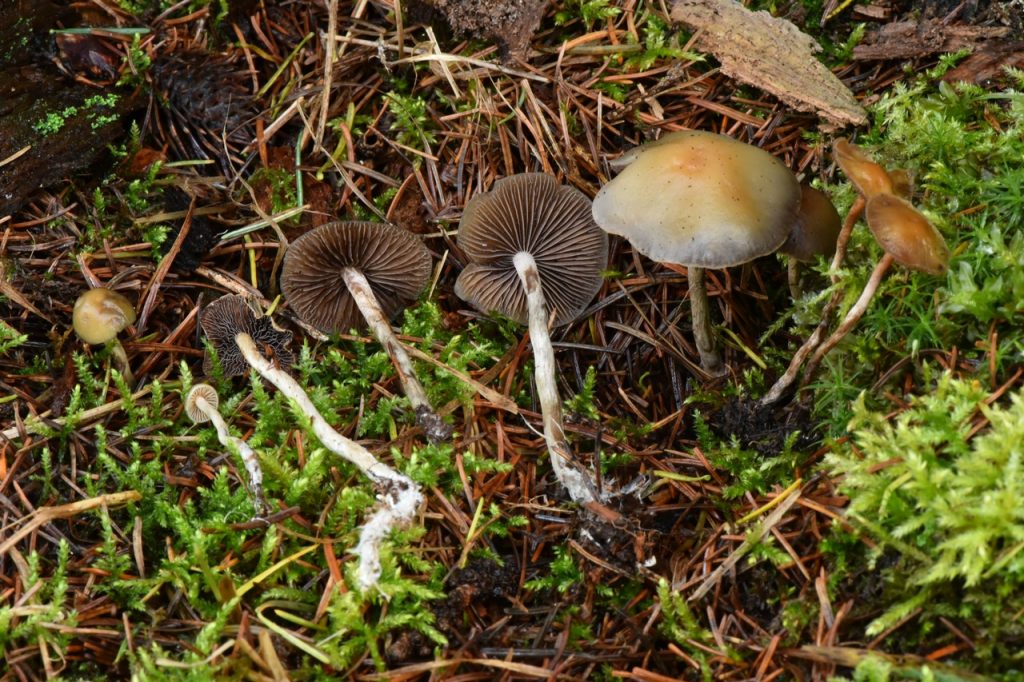Psilocybe aztecorum[i][ii] may have been one of the mushroom species used ceremonially by the Aztecs, though it’s hard to be sure—the Aztec people still exist, and some communities still use mushrooms in traditional ways, but it’s hard to know exactly what species were in use hundreds of years ago. Certainly, P. aztecorum grows in Central America, meaning the Aztecs did have access to it traditionally, and it is psychoactive. Some sources report that one or more other species have been found to be the same as P. aztecorum, meaning this species’ range might actually cover much of North America.
Identification and Description
Cap: Small, slimy, initially bell-shaped, becoming flat with a central depression with age. Color depends on age and whether the cap is wet or dry. It can be yellow-gold, brownish-gray, or even whitish. Does not bruise blue, although the margins may develop blue-green staining.
Stem: Proportionately tall, white to gray, sometimes with green stains. There may be a faint ring, but it is soon lost. The base of the stem is covered by root-like rhizomorphs.
Gills: Pale violet-gray to dark violet-brown. The edges may be white. Very young specimens have the gills covered in a cobwebby veil.
Spores: Elongated-ellipsoid. Often asymmetrical, and unusual shapes aren’t uncommon.
Spore Print: Black-violet.
Edibility: Psychoactive.
Habitat: Feeds on woody debris in woodlands dominated by conifers.
Range: Central America and parts of North America, they have been documented in Maine and Quebec.
This species is a perfect example of the fact that bluing is not a reliable indicator of potency, for this mushroom, rumored to be quite potent, generally doesn’t bruise blue at all. Some parts may turn slightly blue-green.
Look-alikes
As already mentioned, there are mushroom populations previously considered separate species that may actually be P. aztecorum. These must be its closest look-alikes. But all Psilocybes look somewhat alike, and all bear a more than passing resemblance to a huge number of small, brownish, nondescript mushrooms (the LBMs or “little brown mushrooms”), some of which are dangerously toxic. It’s not that LBMs can’t be distinguished from each other, it’s that the differences are easy to overlook in a moment of laziness. Properly keying out LBMs is a must for foragers, a warning that’s especially important for people familiar through Psilocybes only from use or cultivation; do not eat anything just because it looks like the mushrooms you buy or grow. People have died mistaking Deadly Galerinas for innocent shrooms.
Effects
Sources tend to focus more on the cultural role this species plays (assuming it is one of the mushrooms considered “flesh of the gods,” as seems likely) than on what using it is actually like. Most likely, the effects of P. aztecorum are either exactly like, or differ only subtly from those of P. cubensis, since both contain psilocybin. That means altered mood (usually euphoria and a feeling of connectedness, occasionally debilitating anxiety), altered perception, and altered thought-patterns.
Altered perceptions—that is, hallucinations—get all the press, to the point that many people refer to psychoactives simply as hallucinogens, as though that’s all they do. Actually, seeing stuff is usually the least important effect for users, who are much more interested in euphoria and in the altered thinking that often includes important personal and spiritual insights. Psilocybin doesn’t even cause hallucinations at very low doses, and even at moderate doses the visions are usually subtle (walls breathe, tree branches appear geometric or cartoonish, and so forth). Only at very high doses is it possible to see things that aren’t there at all. High doses are also seriously mind-altering and are by no means recommended for beginners.
Potency and Dosage
P. aztecorum is said to be of moderate to high potency, but it doesn’t seem to have been extensively tested for psilocybin content. And again, there isn’t a lot of documentation on what using this species is actually like. That means it is up to the user to establish a dosing guide for themselves through trial and error—and it is always better to err on the side of taking too little than taking too much because the risk of unpleasant or even dangerous side-effects goes up with dose size. It’s also important to remember that the potency of this species could be variable. Start low, go slow, as they say.
Growing
P. aztecorum is not known to have been cultivated[iii]. It’s not clear whether it can be.
Toxicity, Safety & Side Effects
If P. aztecorum use has any unique risks or associated problems, it hasn’t been documented. That means that such problems can’t be ruled out, but most likely the risks are those of psilocybin generally.
The most obvious danger with psilocybin use is legal, as possession or use in most jurisdictions is very much against the law, and penalties can be draconian. There are also various side effects—fortunately, the common ones are mostly minor (nausea, balance problems), and the severe ones (convulsions, even death) are rare. Where intense anxiety fits into the scale of severity is hard to say. It’s important to follow certain basic safety procedures when using psilocybin, especially for beginners or people trying doses higher than those they’ve tried before. One such precaution is to err on the side of taking too little rather than too much, as the risk of severe side effects increases with dose.
It’s worth noting that psilocybin is, technically, a toxin—it’s simply a toxin whose effects some people like or even find helpful in various ways. But accidental ingestion of P. aztecorum, or any other psilocybin mushroom, should be treated as a case of mushroom poisoning, with medical help sought accordingly, especially if the victim is a child (or a pet!). An unwanted, unexpected trip could be terrifying, and there is the possibly of those more severe side-effects to consider. Users of these mushrooms should take great care to ensure that mushrooms or mushroom products—especially candies—do not end up in the wrong hands.
References:
[i] Rockafeller, A. (n.d.). Psilocybe aztecorum R. Heim. Shroomery



